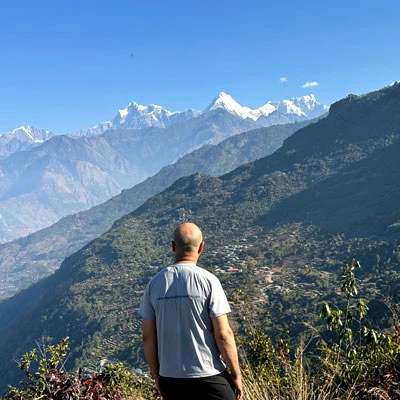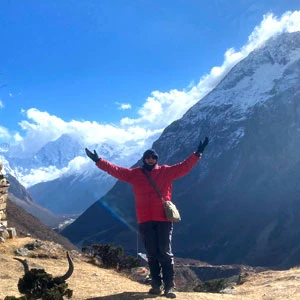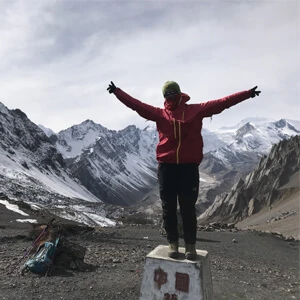As this trekking route takes you through lush forests, terraced farms, and traditional villages, each season will have a different feel to the Himalayas. So, what is the best time for Khopra Danda Trek?
Among the four major seasons in Nepal, the Spring (March, April, and May) and Autumn (September, October, and November) are the best seasons for the Khopra Danda Trek.
Yet again, you can embark on this trek in the season you prefer or the challenges you are searching for. Hence, it is essential to understand the different merits and demerits of trekking while in different seasons to know what you prefer.
Furthermore, after knowing what each season offers, you should check if it matches your style. Altogether, stick with us to find the ideal trekking season and the factors you should consider while choosing the best time for Khopra Danda Trek.
Best Time For Khopra Danda Trek
The Khopra Danda Trek takes you to a maximum altitude of 3,660 meters / 12,008 feet which makes the trail accessible all year round. Indeed, the trek has a high altitude but it does not go to an extreme.
For most of the trek, you will be spending above 2,500 meters, therefore, it is only wise to prepare yourself for unpredictable weather conditions.
Spring (March, April, And May)
After waking from the long winter sleep, the region brims back to life, gradually kickstarting the Spring season. It is a delightful time of the year as the trekking trails are adorned with lush rhododendron forests and other wildflowers.
With the Spring season, everything starts to gain a fresh perspective with new twigs and blooms in the making. Additionally, the valleys are filled with lush greenery and the air is fresh and fragrant with the scent of blossoms.
Moving on, the weather during this time of the year offers excellent visibility, offering panoramic views of the Annapurna and Dhaulagiri ranges. Likewise, even though Spring is a peak season, it has fewer crowds than during the Autumn season, providing a more tranquil season.
Talking about the temperature, the Spring season starts to gradually warm up the trails. Here, the average daytime temperature can range between 10°C to 20°C (50°F to 68°F) while the nighttime temperatures can drop to around 5°C to 10°C (41°F to 50°F).
Furthermore, the clear visibility during this season allows you to witness wildlife such as pheasants, snow leopards, yaks, Himalayan Tahr, Himalayan Monal, Barking Deer, Himalayan Langur, Musk Deer, Wild Boar, and many more.
Lastly, some of the trekking highlights for the season are as mentioned below.
- Comfortable and moderate temperature.
- Higher probability of encountering wildlife in the region.
- Vibrant forests with varieties of rhododendrons, wildflowers, and lush greenery.
Autumn (September, October, And November)
With clear skies and crisp air, the Autumn season is one of the peak seasons for this trek. After season-long rain showers and cloudy skies, Autumn brings in a new breath of fresh air. Additionally, this season offers the best views of the Himalayas due to a lower precipitation rate.
As this season is right after the end of the monsoon season, the trails are much more favorable and have no muddiness. Altogether, the season will be particularly dry with no obstruction in the sky hence, making it a perfect paradise for photographers and travelers alike.
Advancing, the temperature is also comfortable and moderate. At this time of the year, the daytime temperatures range from 10°C to 20°C (50°F to 68°F), while nighttime temperatures can drop to 0°C to 10°C (32°F to 50°F).
Overall, the Khopra Danda Trek during Autumn is a soulful journey. It is also a chance to immerse yourself in the culturally rich background of this region as the atmosphere is completely soaked in the festive mood.
Here, one of the most important things to note is the vibrant colors that breathe the valley into life. During Autumn, the leaves start to retire for Winter hence, turning themselves into the colorful hues of yellow, orange, red, and golden. Thus, seeing this beautiful color contrast on the white snow-clad mountains is indeed a sight to behold.
Lastly, some of the trekking highlights for the season are as mentioned below.
- Vibrant and colorful environment.
- Stable weather, moderate temperature, bright sunshine, and blue skies.
- Optimal trekking conditions with little to no probability of occurrence of natural calamity.
- Ripened crops in the farm field.
- Upgraded backdrop with colorful fall foliage for photography.
Winter (December, January, And February)
From the end of November, the cold slowly starts to creep in. This particular cold sets itself throughout the trail, marking the beginning of the Winter season. Here, it creates a magical atmosphere with snow-covered trails and cold air.
Usually, the temperature on this trail gets chilly with the daytime highs ranging from 0°C to 10°C (32°F to 50°F). Likewise, the nighttime lows often drop below freezing, sometimes reaching -10°C (14°F) at higher altitudes.
Moving on, you will feel the air get drier. Since this trek does not take you to an extreme altitude, you can embark on it even during Winter. However, if you are trekking at this time of the year, make sure to pack insulated clothing and sleeping bags rated for sub-zero temperatures.
Having said that, it should be known that the trekking trail gets much harder during the Winter and it may not be everyone’s cup of tea.
Summer / Monsoon (June, July, And August)
As soon as the Spring season comes to an end, the heavy Monsoon season follows. From the end of May month, you will start to see occasional showers which soon turn into continuous rainfall day and night with only a few sunny days.
During this season, the heavy rain keeps the forests and landscapes filled with lush greenery. Additionally, you will also see the water bodies in their full form unlike in any season.
While the scenery gets extraordinarily beautiful, the trekking trail gets more demanding. At lower elevations, this continuous rainfall results in natural calamities such as landslides which as a result, block the roadways. Furthermore, there will be little to no visibility at all during the season due to the presence of thick rain-filled clouds.
Moving on, the trekking trails during the Monsoon season get wet, muddy, and slippery which requires you to be extra cautious on the journey. Again, if you are trekking during this season, you should prepare yourself for rain and be fine with not being able to enjoy the view. Also, prepare for the amount of leeches along the way.
Anyways, the temperature during this season is warm and the air has increased humidity. Typically, the daytime temperatures on the trek range from 15°C to 25°C (59°F to 77°F), while nighttime temperatures hover around 10°C to 15°C (50°F to 59°F).
Factors To Consider When Choosing The Best Time
From weather conditions, and trail management, to the crowd levels - it all plays an important part when it comes to choosing the best time for the Khopra Danda Trek. Each season can either make or break your journey hence, it is also crucial to ask yourselves some questions regarding the time of the trek.
Chilly and frosty weather or moderate and cool weather? Crystal clear skies or the possibility of a dynamic environment? Comfortable journey or a challenging adventure? Also, serene trails or the ability to meet fellow trekkers?
With these many questions in mind, the time you choose to trek must align with your travel style.
Weather And Climate Conditions
Although the Khopra Danda Trek does not take you to an extreme altitude, the weather does get pretty unpredictable, especially during the Monsoon and Winter seasons. Since your comfort and enjoyment depend heavily on the weather conditions, it is one of the most important factors to consider.
For this journey, if you imagine yourself walking past the lush rhododendron forests listening to the chirping of birds, and feeling the whoosh of fresh air on your hair, then, Spring and Autumn are the best bet for you.
However, if you are seeking a snow-kissed adventure or a quieter lush greenery around you, Monsoon or Winter should be the seasons you choose.
Fitness Level And Experience
As the Khopra Danda Trek does not take you to a high elevation, this trek is easy that even a beginner can accomplish. However, having said that, this trek will require walking at least 5 to 6 hours daily therefore, trekkers must have good physical fitness. Additionally, you will come across several steep ascents along the trail thus, you should be physically prepared for it.
Even though you may not have been involved in trekking even once in your life, you will not struggle on this journey, if you have a consistent workout routine. Likewise, if you have never been on a short journey nor do you ever exercise, then, it will create a huge issue during this trek.
Hence, you should start exercising to make this trek a rewarding journey. Here, simple exercises such as jogging, running, swimming, and cycling will help you a lot. Additionally, small stretches before each day and a quick meditation also contribute to a better day.
Moving on, even as we do not trek to an extreme altitude, it is crucial to understand altitude sickness and be prepared for it. Whether you are an experienced or novice trekker, anyone can suffer from it, and there is no telling with whom.
The early symptoms of altitude sickness are dizziness, nausea, shortness of breath, fatigue, and mild headaches. As soon as you come across such symptoms, you should stop your journey and give it a rest. However, if you find the symptoms getting severe, bail immediately and descend.
Crowds
Generally, trekking during the peak seasons of Spring and Autumn means having to share the trail with multiple fellow partners. Since the weather is stable, the temperature is moderate, and the sky is clear, most tourists flock during the season.
With the busy trails of the seasons, the accommodation plans are completely booked which will create a hassle if you are waiting to book at the last minute. If you love socializing with others and have the mentality of “the more, the merrier,” then the peak season will be your favorite. Whether you can book your trip with one of the highly rated local agencies like the Nepal Trekking Experts, or we recommend you book your accommodation in advance for peak season.
Now, if you do not like the idea of having a crowd, then you can also opt to trek during the start or the end of the peak season. In fact, during these times, you will get to have a more intimate time with nature. Having said that, you may face occasional rain showers nearing the end of Spring or early start of the Autumn season. Likewise, if you plan to trek during the early start of Spring or the end of Autumn, you will have light snowfall.
However, if you are trekking during the off-season of Monsoon or Winter, you should understand that you will not have great visibility. Well, with continuous downpours or snowfall, the sky is filled with fog or rain clouds that may hamper your mood. Yet, if this unpredictable weather does not bother you, make sure to always add a buffer period to avoid trekking on a tight schedule.
Indeed, off-season trekking is not for everyone, as it requires a lot of patience, endurance, and determination.
Essential Tips For Khopra Danda Trek In Different Seasons
Essential Gear And Clothing For Each Season
The trick to pack for a trek is to add all the necessary items without overpacking. While you will not be required to pack technical items, you will still need to prepare according to the weather. Since the weather can get unpredictable, packing for this trek indeed gets tricky.
Here are the suggested gear and clothing for the Khopra Danda Trek.
Headwear & Handwear
- Sun hat
- Sunglasses
- Beanie
- Woolen gloves
Footwear
- A well-worn water-proof trekking boots with good ankle support.
- Camp shoes and slippers
- Gaiters (for Winter)
- Moisture-wicking socks (thin & lightweight)
Clothing
- Breathable underwears
- Hiking trousers (woolen or fleece)
- Waterproof shell pants & jackets
- Quick-drying shirt
- Fleece wind-breaker jacket
- Down jacket
Added Items
- Sleeping bag (-15/20°C)
- Medium rucksack (50–70 liters (3000–4500 cubic inches))
- Waterproof rucksack cover
- Personal medicine
- Sun hat
- Sun protection cream
- Lip Guard
- Wet wipes
- Towels
- Nail Clipper
- Female hygiene products
- Handwash
- Soap bar
- Chargers
- Adapters
- Binoculars
- Camera
Permits Required During Khopra Danda Trek
As the Khopra Danda Trek takes place within the Annapurna Conservation Area, you will need a permit to enter this restricted region. Here, the two permits you will need are the Annapurna Conservation Area Permit (ACAP) and the TIMS (Trekkers' Information Management System) card.
Here, the ACAP is to enter the Annapurna Conservation Area while the TIMS card is to ensure your registration as a trekker. Well, these permits are quite affordable. The ACAP will cost you NRs 3,000 while the TIMS card will cost you NRs 2,000.
You can easily get ACAP in the Nepal Tourism Board office in either Kathmandu or Pokhara. As for the TIMS card, you will get it from an authorized trekking company in Kathmandu or Pokhara.
Health & Safety Considerations During Khopra Danda Trek
Although the Khopra Danda Trek is relatively easier than the other treks in the Annapurna region, you should be well-prepared. Before embarking on this journey, you must buy an insurance plan.
Having a travel insurance plan will cover any losses during the journey. Additionally, in case of any unforeseen circumstances, this plan will cover your medical expenses as well as the expensive cost of emergency helicopter evacuation.
Hence, while buying an insurance plan, you should always check their policy to see if it covers the altitude level you are traveling to. Furthermore, some of the insurance plans will not pay you upfront, in fact, you will have to reimburse them later. Therefore, check the policy and buy a plan that will immediately cover your medical bills.
Below are some of the tips that you must follow during the Khopra Danda Trek.
- Stay hydrated and drink at least 3 to 5 liters of water every day.
- Avoid alcoholic beverages and smoke at all costs, especially at higher altitudes.
- Carry a small first-aid kit and do not forget to pack your medication, if there are any.
- Dress up in layers to adapt to the changing weather.
- Do not skip any meals and eat well. A balanced nutrition will maintain your energy level and support acclimatization.
- Be aware of the symptoms of altitude sickness. Take proper rest and if the symptoms worsen, bail and descend slowly.
- Follow your guide’s instructions and stick to the original trekking trail.
- Monitor the weather forecast before you embark on your daily journey. It will help you avoid bad weather.
Conclusion
You can capture the real essence of the Khopra Danda Trek during the peak seasons of Spring (March to May) and Autumn (September to November). These seasons give you the most breathtaking views of the Himalayas with unobstructed views, clear skiers, and seasonal bloom of the flowers.
While you can also embark on this journey during the other season of the year, the trail gets a bit more demanding than usual. During Monsoon (June to August) and Winter (December to February), the trails and views are obstructed by heavy rainfall and snow.







